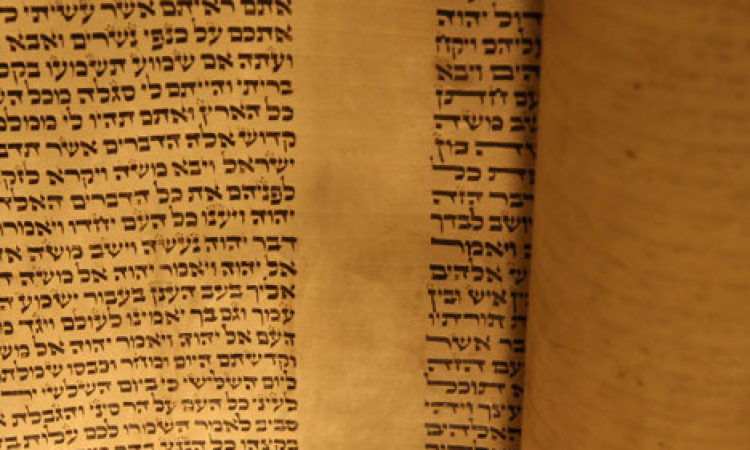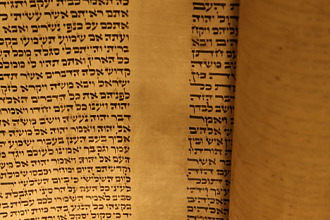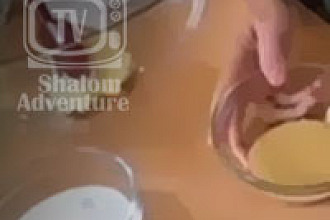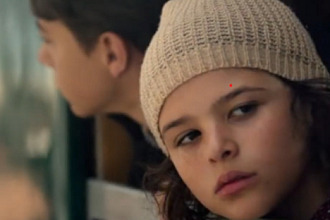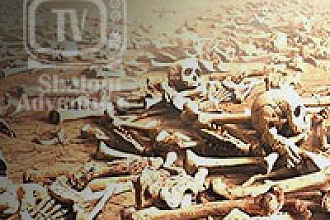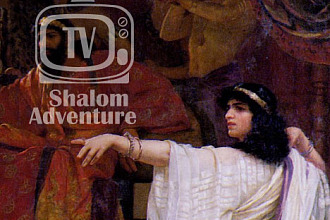Parasha for the Week: Baha’Alotcha Numbers 8:1 – 12:16
Haftara for the Week: Zechariah 2:14 – 4:7
Apostolic Writings: Revelation 1:12 - 20
Overview:
Aharon is taught the method for kindling the menorah. Moshe sanctifies the levi’im to work in the Mishkan. The levi’im replace the first-born, who were disqualified after sinning at the golden calf. The levi’im are commanded that after five years of training they are to serve in the Mishkan from ages 30 to 50; afterwards they are to engage in less strenuous work. One year after the Exodus from Egypt, G-d commands Moshe concerning the korban Pesach. Those ineligible for this offering request a remedy, and the mitzvah of Pesach Sheni is detailed, allowing a “second chance” to offer the korban Pesach one month later. Miraculous clouds that hover near the Mishkan signal when to travel and when to camp. Two silver trumpets summon the princes or the entire nation for announcements.
The trumpets also signal travel plans, war or festivals. The order in which the tribes march is specified.
Moshe invites his father-in-law, Yitro, to join the Jewish people, but Yitro returns to Midian. At the instigation of the eruv rav — the mixed Egyptian multitude who joined the Jewish people in the Exodus — some people complain about the manna. Moshe protests that he is unable to govern the nation alone. G-d tells him to select 70 elders, the first Sanhedrin, to assist him, and informs him that the people will be given meat until they will be sickened by it. Two candidates for the group of elders prophesy beyond their mandate, foretelling that Yehoshua (Joshua) instead of Moshe will bring the people to Canaan. Some protest, including Yehoshua, but Moshe is pleased that others have become prophets. G-d sends an incessant supply of quail for those who complained that they lacked meat and a plague punishes those who complained. Miriam tries to make a “constructive remark” to Aharon that implies Moshe is only like other prophets. G-d explains that Moshe’s prophecy is superior to that of any other prophet, and punishes Miriam with tzara’at because she gossiped about her brother. Moshe prays for her, and the nation suspends travel until she is cured.
"Furniture of the Sanctuary"
The Torah states: “Hashem spoke to Moses saying, ‘Speak to Aaron and say to him: When you erect the lamps, the seven lamps are to illuminate the area in front of the menorah.’ Aaron did so. He erected the lamps facing forward so they illuminated the area in front of the menorah, just as Hashem had commanded Moses.” (Numbers 8:1–3). The whole Sanctuary symbolically describes G-d’s plan of salvation. That is why the furniture of the Sanctuary represents the phases and actions of the Messiah, who is the masterpiece of the plan of salvation. Some of its furniture have a double application, they represent the Messiah and G-d’s people as well. That is the case of the Menorah. It represents the light of the Messiah, but also the light that G-d’s people shine in this world.
The Menorah is, in the biblical tradition, a tree of gold made from one piece, hammered out by repeated blows of the hammer, from rootstock to blossom
G-d showed the Menorah as a tree of life representing the whole future G-d’s people. Thus, the right question to ask is if we have been hammered enough in order to shine, as the prophet Isaiah said: “Arise, shine, for your light has come! The glory of HASHEM has risen on you. For behold, darkness covers the earth, and deep darkness the peoples. But HASHEM will arise upon you, and His glory will appear over you. Nations will come to your light, kings to the brilliance of your rising.” (Isaiah 60:1–3). Without the light of the Menorah the holy place of the Sanctuary would be in darkness; without the light of all believers the world will be in darkness. that is why we must shine in order to illuminate the nations.
Fire, light and flame are the symbol of the Ruach Hakodesh, the Spirit of G-d. They denote the presence of G-d (Exodus 3:2), and also represent G-d’s protection (Exodus 13:21), but also the approval of G-d (Leviticus 9:24). When Yochanan Hamatbil (John the Baptist) introduced Yeshua to his disciples, he said “He will baptize you with the Holy Spirit and fire” (Matthew 3:11). Yeshua did it when he sent the Holy Spirit to his disciples on the day of Shavuot. The Ruach Hakodesh is certainly the most extraordinary gift we can receive from G-d. The Ruach Hakodesh is represented by the main shaft or flame of the Menorah at the center. From this main shaft six branches or flames issue, three on the left side and three on the right side. Six flames or lights represent the main gifts given by the Ruach Hakodesh: gift or spirit of wisdom, gift or spirit of understanding, gift or spirit of counsel, gift or spirit of might, gift or spirit of knowledge and gift or spirit of fear of Hashem, all these six gifts are listed in Isaiah 11:2 as spiritual equipment of the Messiah “Then a shoot will come forth out of the stem of Jesse, and a branch will bear fruit out of His roots. The Ruach of HASHEM will rest upon Him, the Spirit of wisdom and insight, the Spirit of counsel and might, the Spirit of knowledge and of the fear of HASHEM.” (Isaiah 11:1–2), that is why one of the first quality of the Mashiach is to be a light in this world. “In him was life, and the life was the light of men. The light shines in the darkness, and the darkness has not overcome it. . . . The true light, which gives light to everyone, was coming into the world.” (John 1:4-5, 9).
" Ordination of the Cohanim"
In the parashah for this week we have the consecration or ordination of the Cohanim. It is a new description of the consecration of Aaron and his sons before performing their services in the sanctuary: “Again HASHEM spoke to Moses saying, ‘Take the Levites from among Bnei-Yisrael and ceremonially cleanse them.’” (Numbers 8:5–6), this text could be read in parallel with the description of their consecration in Exodus 40:12-16 and Leviticus 8. “After you have purified them and presented them as a wave offering, the Levites will come to do their work at the Tent of Meeting. For they are the ones from among Bnei-Yisrael given to Me in place of all the first from the wombs of Bnei-Yisrael. I have taken them for Myself.” (Numbers 8:15–16). As we said before, G-d’s will was that the whole people of Israel would be a people of priests, and the firstborn would be those who would have to lead the services, but at the Golden Calf sin, G-d saw that the people were not ready for this function, and since the tribe of Levi stood up with Moses to defend G-d’s honor and will, G-d decided to give the priesthood to the tribe of Levi: “So I am taking the Levites in place of the firstborn of Bnei-Yisrael, (Numbers 8:18). In his original plan, G-d wanted the chief of each family to be consecrated as a priest, “HASHEM spoke to Moses saying, ‘Consecrate to Me all the firstborn, from every womb of Bnei-Yisrael, both men and animals—this is Mine.” (Exodus 13:1–2). It is interesting to notice that G-d calls Israel His firstborn, “This is what HASHEM says: ‘Israel is My son, My firstborn.” (Exodus 4:22). That is why the whole people of Israel should be a people of priests. “’So as for you, you will be to Me a kingdom of kohanim and a holy nation.’ These are the words which you are to speak to Bnei-Yisrael.” (Exodus 19:6). It was the case with Abraham, Isaac and Jacob who were the Patriarchs and the priests of their family. It was the spiritual privilege of the first born. And much more after the last plague of Egypt, all the first born belonged to G-d, because on the night of Passover, He could take their life, but spared them. “For every firstborn among Bnei-Yisrael is Mine, whether human or animal. On the day I struck down the firstborn of the land of Egypt, I sanctified them for Myself.” (Numbers 8:17). But the firstborn of Israel lost this privilege after the sin of the Golden Calf. The Torah states, “For they are the ones from among Bnei-Yisrael given to Me in place of all the first from the wombs of Bnei-Yisrael. I have taken them for Myself.” (Numbers 8:16). The Levites took the place of the first born, “So I am taking the Levites in place of the firstborn of Bnei-Yisrael,” (Numbers 8:18).
Haftarah: Zechariah 2:14 - 4:7
As the Parashah is about Aharon, our Haftarah is about another priest: “Then he showed me Joshua the cohen gadol.” (Zech. 3:1). Joshua the cohen gadol needs atonement, as shown by the text: “‘Remove the filthy garments from him.’ Then to Joshua he said, ‘See, I have removed your iniquity from you and will dress you with fine clothing.’ ” (Zech. 3:4).
Then in chapter 4 of our Haftarah portion, the menorah comes in view: “He asked me, ‘What do you see?’ I replied, ‘Behold, I see a solid gold menorah with its bowl at the top of it, and its seven lamps on it with seven pipes for the lamps that are on the top of it.’ ” (Zech. 4:2).
Before reading this story of Joshua the cohen gadol, it is good to look at the context. The end of chapter 2 of Zechariah gives a very intriguing text: “‘Sing and rejoice, O daughter of Zion! For behold, I am coming and I will live among you’—it is a declaration of Hashem. ‘In that day many nations will join themselves to Hashem and they will be My people and I will dwell among you.’ Then you will know that Hashem-Tzva’ot has sent me to you. Hashem will inherit Judah as His portion in the holy land and will once again choose Jerusalem. Be silent before Hashem, all flesh, for He has aroused Himself from His holy dwelling.” (Zech. 2:14-17).
This text in Zechariah 2 is a beautiful declaration of Hashem. After giving several visions to the prophet, Hashem declares, “I am coming and I will live among you.” Many texts of the prophet Zechariah are messianic texts, which means these texts are referring to the Messiah. Texts such as “Behold, I will bring forth My servant the Branch” (Zech. 3:8) are seen as messianic, for this “Branch” is the branch (descendant) of Jesse and King David (Is. 4:2, 11:1, Jer. 23:5), which has always been understood by the Jewish and Christian traditions as the Messiah living on earth. In chapter 6 of Zechariah we find more that is written about this “Branch:” “Thus says Hashem-Tzva’ot: Behold, a man whose Name is the Branch will branch out from His place and build the Temple of Hashem. He will build the Temple of Hashem. He will bear splendor and sit and rule on His throne. Thus He will be a cohen on His throne. So a counsel of shalom will be between them both.” (Zech. 6:12-13). That is why even though there are Jews who are preparing everything for a future temple, they don’t try to build it, because they say that is the role of the Messiah: when the Messiah comes, he will build the temple. This idea comes from this text of Zechariah. Another text that is received by Jews and Christians as a messianic text is from chapter 9: “Rejoice greatly, daughter of Zion! Shout, daughter of Jerusalem! Behold, your king is coming to you, a righteous one bringing salvation. He is lowly, riding on a donkey—on a colt, the foal of a donkey.” (Zech. 9:9). We see this text fulfilled by Yeshua in Matthiew 21:1-11. It is interesting that both of these texts describing the coming of the Messiah invite God’s people to rejoice: “‘Sing and rejoice, O daughter of Zion!” (Zech. 2:14) and “Rejoice greatly, daughter of Zion! Shout, daughter of Jerusalem!” (Zech. 9:9).
Apostolic Writings: Revelation 1:12 - 20
The Menorah Aaron and his sons have to light in the Sanctuary has several meanings. It is the symbol of the shining light of the Messiah and shining light of G-d’s people. It is certainly the reason why the Menorah looked like a tree with its roots (base), branches and flowers (Exodus 25:31–32), which is also a metaphor of G-d’s people. The Menorot (lamp-stands) symbolizing the shining light of G-d’s people is the key illustration to understand the first chapters of the book of Revelation called in Hebrew “Hitgalut Yeshua Hamashiach”, a revelation from Yeshua.
Before going further, it is important to clarify some points about this book of Revelation or of Hitgalut. I like these titles even though in the original Greek the title is Apokalupsis, or as it is given in French Apocalypse. Most of the time, this word, wrongly inspires fear to people. It became the synonym of catastrophe, end of the world. However, this book is, as it is translated in English and in Hebrew is a Revelation from Yeshua about the history of G-d’s people. And what we must know about this book is that only a Jewish believer in Yeshua could write it, and only those who are very knowledgeable of the Tanach (Hebrew Bible) can understand it. This book is full of quotations from the Hebrew Bible, in fact 68% of this book are direct quotations, allusions or references from the Hebrew Bible. All the metaphors are from the Hebrew Bible. The full book is structured in the way the Hebrew Bible is structured. This Hebrew poetry is called “Chiastic” from the Greek letter X where the first part is in connection or parallel with the last part and the second part is in connection with the penultimate part of the text etc. This structure of Revelation and each segment of this book can be outlined as A, B, C, D, C’ B’, A’. A at the beginning goes with A’, B goes with B’ and C goes with C’ and D is the central part of revelation. The diagram we can draw is this one:
Introduction (1:1-8)
A. The 7 Churches: (1:9-3:22)
B. The 7 seals: (4:1-8:1)
C. The 7 trumpet: (8:2-11:18)
D. The 3 Monsters (11:19-14)
D1 The dragon & the women
D2 The Beast of the Sea
D2’ The Beast of the earth
D1’ The Lamb & G-d’s people
C’ The 7 plagues: (15:1-18:24)
B’ The supper of the Lamb and the millennium (19:1-21:4)
A’ The Church on the new earth (21:5-22:5)
Conclusion (22:6 - 21).
The influence of the Hebrew Bible on this book of Revelation is so great that each part of the book is introduced by a description of the Israelite sanctuary:
A. The High Priest among the 7 Menorot.
B. The Lamb who was slain
C. The altar with a golden censer
D. G-d’s temple in heaven was opened, and the ark of his covenant was seen within his temple.
C’ The sanctuary of the tent of witness in heaven was opened
B’ The loud voice in heaven . . . Salvation and glory and power belong to our G-d,
A’ The gates the names of the twelve tribes of the sons of Israel were inscribed, which remand us the twelve tribes sitting around the sanctuary in the wilderness.
Coming back to the first chapter, when Yochanan, the writer of this book, heard a voice, he turned his face towards the voice and saw 7 golden Menorot, and in the midst of the Menorot Yeshua walking “Then I turned to see the voice that was speaking to me. And when I turned, I saw seven golden menorot. In the midst of the menorot, I saw One like a Son of Man, clothed in a robe down to His feet, with a golden belt wrapped around His chest” (Revelation 1:12–13). The vision of Yeshua is extraordinary, he looks like the Eternal G-d “His head and His hair were white like wool, white like snow, and His eyes like a flame of fire. His feet were like polished bronze refined in a furnace, and His voice was like the roar of rushing waters” (1:14–15). And when Yeshua spoke to Yochanan He applied to Himself one of G-d’s title “I am the First and the Last, and the One who lives” (17–18), this affirmation was already said by G-d: “I am he; I am the first, and I am the last.” (Isaiah 48:12b).
In this Revelation, which is an unfolding of the future of G-d’s people as iit is written in the first verse: “G-d gave Him to show to His servants the things that must soon take place, Yeshua reveals to Yochanan that His people will have a great mission on the earth, “to be a light to the nations” and to reveal to the world the plan of salvation, which is in fact the victory of G-d in a great conflict between Yeshua and Satan (Revelation 12). The light of Yeshua’s people is symbolized by the Menorot, he said clearly “the seven menorot are the seven congregations” (1:20). These seven congregations are described in the chapter 2 and 3 of the book of Revelation, revealing G-d’s message during the seven periods of human history, between the first and the second coming of Mashiach. The last component of their messages is a promise given to each one who participates to share the last message “I will grant him to sit with me on my throne, as I also conquered and sat down with my Father on his throne” (Revelation 3:21). this is one of the promises made by Yeshua for everyone who follow him as his disciple and share the light he received from him. That was already expressed by Yeshua when he said, “You are the light of the world. A city set on a hill cannot be hidden. Neither do people light a lamp and put it under a basket. Instead, they put it on a lampstand so it gives light to all in the house. In the same way, let your light shine before men so they may see your good works and glorify your Father in heaven.” (Matthew 5:14–16).
Yeshua is the one who has the key of the resurrection, “and the One who lives. I was dead, but look—I am alive forever and ever! Moreover, I hold the keys of death and Sheol” (Revelation 1:18), it is the best news we could share with other. Death has been defeated, when Yeshua will come back all our dears will be resurrected by Yeshua. This good news deserves to be written: “Therefore write down what you have seen, what is, and what will happen after these things.” (Revelation 1:19). and more revelation are coming: “As for the mystery of the seven stars that you saw in My right hand, and the seven golden menorot—the seven stars are the angels of Messiah’s seven communities, and the seven menorahs are the seven communities.” (Revelation 1:20), these congregations are described in the next chapters of Revelation, but that is another story.

